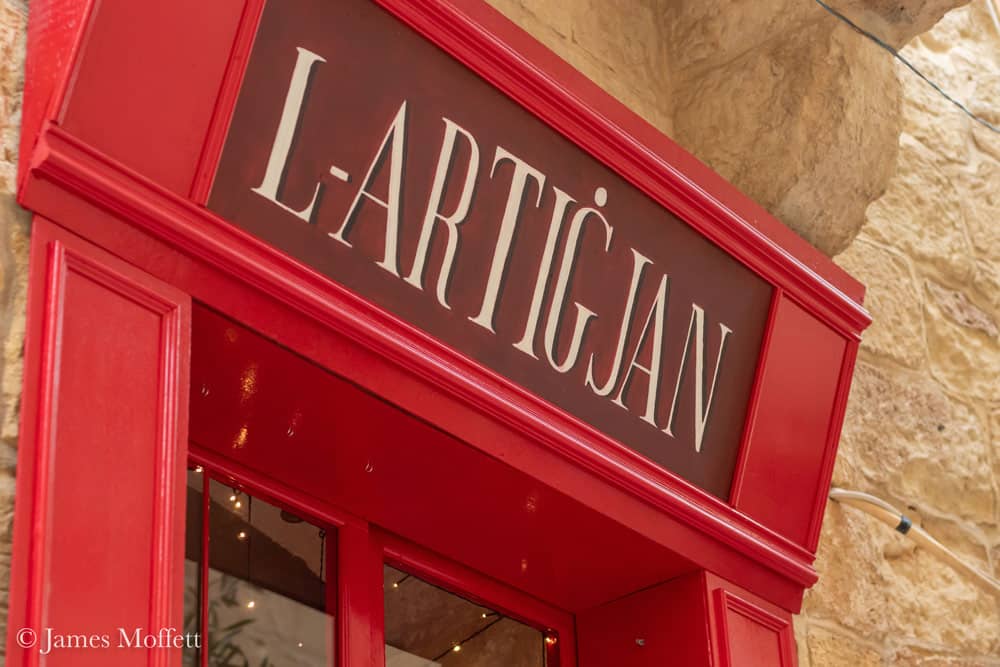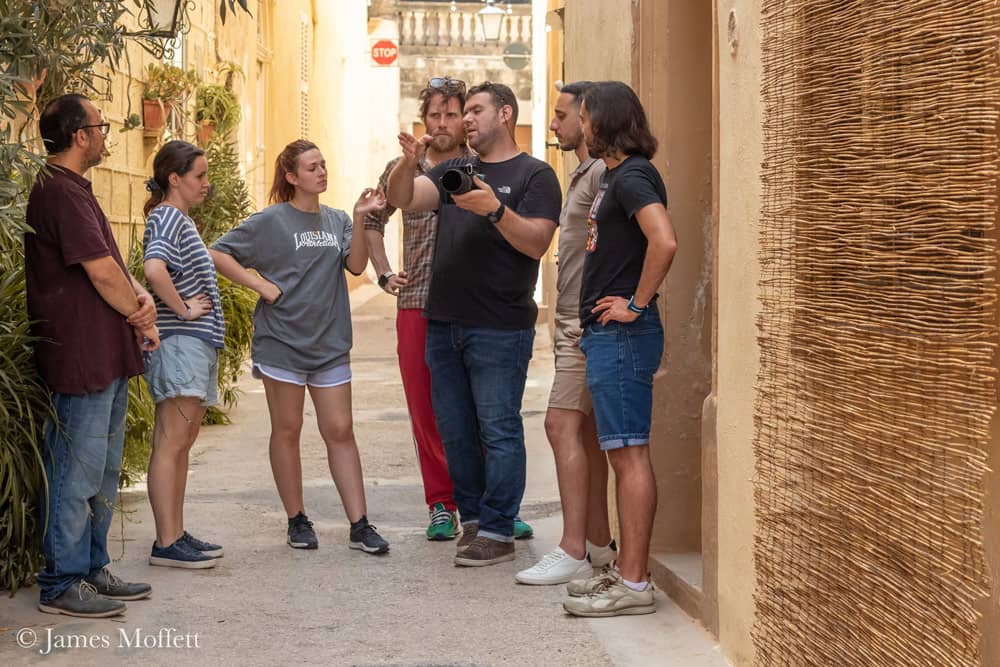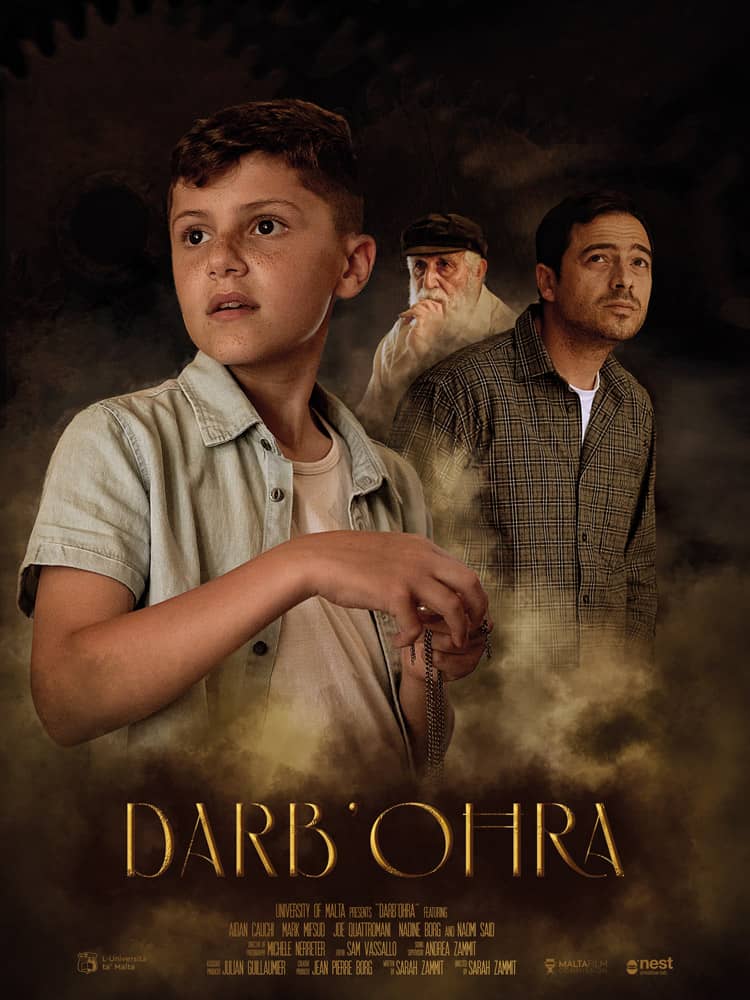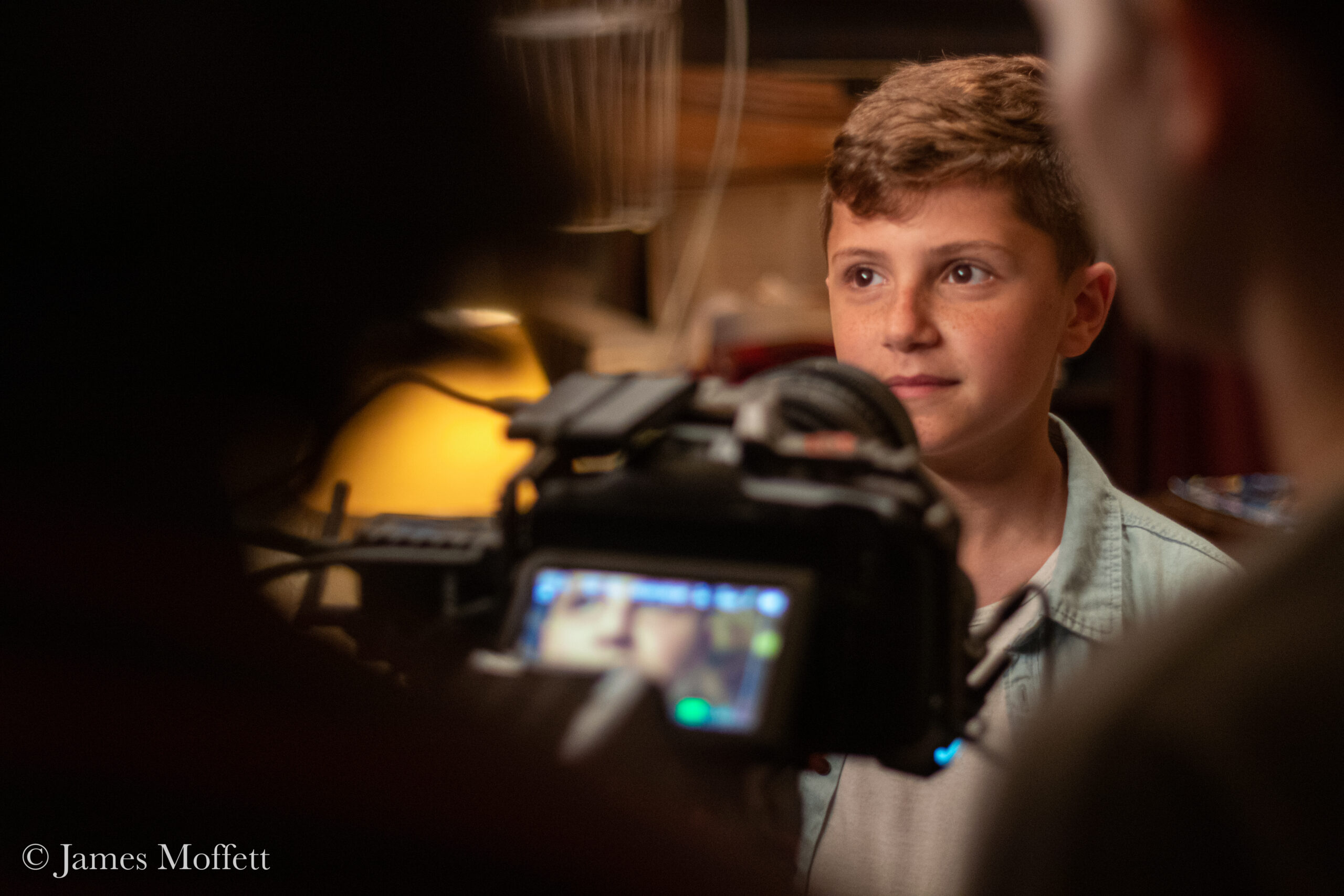THINK talks with director and writer Sarah Zammit on her short film Darb’oħra, and its journey from script to screen
It is five o’clock on a cool Maltese morning. Summer is just a week away. Within a narrow street winding down through the heart of Żejtun, a sense of expectancy seizes the air. The unmistakable characteristics of a shop with a bright red outer frame, glass-paned windows and door, and a large whimsical sign on top reading: L-Artiġjan (‘The Artisan’) brings vibrancy and colour to the otherwise ordinary. To further complement the almost Parisian atmosphere, coffee tables, wine barrels, bakery signs, and crates stacked full with an assortment of vegetables have been carefully placed close by – all leading towards that same toyshop. The sense of stepping into the past has never been so gripping.
Venturing closer, the windows reveal exquisitely-crafted wooden toys dangling and swaying in the breeze. Once through the door, the visitor is greeted by a small, quaint room acting as the main set. Fine examples of craftsmanship rest upon the several shelves, and bookcases, as well as a working station, all of which litter the confined space.

Then, as if to deceive one’s sense of the past, the illusion shatters.
A second, larger room lying at the further end of the toyshop setup reveals the trick behind the magic. A flurry of movement as several people rush around with script pages, camera equipment, and lighting takes place behind a half-raised curtain. The smell of coffee and croissants pervades the humid stuffiness of the set. The creaking silence is disturbed by the low murmur of brief meetings snatched in between directorial setups, make-up sessions, and scene rehearsals. As bleary-eyed and tired as the twenty-or-so occupants seem, people are clearly enthusiastic.
It is the third and final day of a gruelling 12-hour shooting schedule on a local short film production that will see five film students complete the first part of their end-of-year assignment. Darb’oħra (Another Time), is the brainchild of director and writer Sarah Zammit, who along with another student from the same course, had her script chosen to be shot and edited within ten days, before a screening in front of an audience.
Preparations started months before filming commenced. Second-year students reading for the MA in Film Studies degree offered at the University of Malta submitted nine potential screenplays for development. Once chosen, the Darb’oħra script was supervised by international screenwriters who provided vital insight into the craft. ‘The script did go through quite a few changes. It grew and changed over time,’ says Sarah.
Darb’oħra follows a young boy who finds himself in a toyshop and discovers something unique and quite unexpected. A specific setting was therefore needed that could convey the right atmosphere and environment, while providing efficient technical logistics required for the story.
‘Location was the first, huge challenge,’ recalls Sarah. ‘Our location needed a shop, both external and internal. First we tried to find a shop to rent, but shops in operation were not interested.’ It was a near-impossible task, searching for such a traditional-looking space in a modern, urbanised country. Faced with no other option and running out of time to find the perfect shop that fit the style and tone of the script, the team settled on a townhouse in Żejtun. The owners generously granted unhindered access, not only for the duration of the three-day shoot, but weeks prior to that for the set to be designed. The exterior and entrance hall had to be dressed accordingly and furnished with props and other paraphernalia.
Sarah and her team (primarily four other students who were also selected to help her realise the script) set themselves to work with the assistance of friends and family. ‘We also had to create the façade and front door from scratch,’ she says. ‘We came up with a design. We looked at the door of the actual house, took the measurements and got pieces of wood and perspex, and we built it.’
The whole set is an impressive and inspiring feat, a testament to the dedication and enthusiasm of the entire team – especially the five students who met on an almost daily basis to discuss the next stage of preparation, gather props, contact actors, revise the script, and plan the scenes. ‘Most of the work we did ourselves, because we were passionate about the story,’ says Sarah. ‘We were lucky that everyone involved worked well together. Everyone had a voice; we listened to each other. The teamwork was excellent.’

Two film students from the team, Jean Pierre Borg and Julian Guillaumier, serving as creative producer and associate producer respectively, proved crucial in securing sponsors and establishing contact with the local talent that would help portray the characters from the script. Auditions took place over weeks, with actors being given spontaneous prompts or snippets of dialogue from the screenplay to gauge their respective characters’ attributes and personalities. As the selection process was refined, the chosen actors were brought on set to read their scenes together. This was particularly pivotal with the character of the young boy, Ben, who meets the toyshop owner. As Sarah recalls, ‘I wanted to create a contrast between a young child and an old man. I wanted that age difference. It reminded me of stories like Harry Potter. There’s this idea of the wise old man, like Gandalf or Dumbledore.’
The gruelling task of auditioning eventually paid off when upcoming actors Aidan Cauchi and veteran Joe Quattromani met in the newly-constructed toyshop to rehearse their introductory scenes. The chemistry between the two was evident from the start and further added to the enthusiasm and energy already present within the team. Other actors had to be auditioned and selected to fulfil the roles of the rest of the cast, most notably Mark Mifsud, Naomi Said, and Nadine Borg.
During the preparatory stages, the team worked simultaneously on various aspects of the production. Whilst the auditioning process was taking place, the set was being designed, props were collected, and camera and sound equipment was tested. To translate the fairytale-like concepts of childhood, nostalgia, and magic on screen, lighting – and the way the camera interacts with a scene and its characters – plays a key role.
Michele Nerreter, another film student, was entrusted with the role of director of photography and, under the guidance of industry professional Rodney Gauci and his team, took responsibility for the cinematography and tone of the film. ‘Rodney was instrumental. He was assisting Michele, providing the equipment and guiding us on how to film, how to light, tech stuff, sound.’ Funding from the University of Malta ensured the use of industry-standard technical equipment that would do justice to the level of detail and intricacy that went into the preparation of the film.
While the confined space of the toyshop provided an ideal setting for the scenes laid out in the script, it was a challenging task working with cumbersome equipment alongside the several cast and crew members present on set at any one time. Sarah and Michele worked closely together to ensure the director’s vision came through on camera. The storyboarding and planning of the shots, which had taken place before filming began, ensured an efficient three-day shooting schedule with minor hiccups. Much of what makes Darb’oħra resonate with viewers is the surreal and dreamlike spaces surrounding the characters – the way the shadows move, the glint in a character’s eye, or the light filtering through a window and into the dust-filled toyshop.
Close by, standing behind the camera and as near to the action as possible whilst operating a microphone on a three-metre-long pole, was the fifth student team member, Andrea Zammit. Acting as sound designer for the film, it was Andrea’s primary role to capture the dialogue between characters during shooting and, later on, to record individual effects for every distinct footstep, bell, metal scrape, piece of clothing, thud, bang, and numerous other sounds playing on screen.
Throughout those three days of shooting, everything ran like clockwork; an ironic observation, given how the film’s own themes explore the unforgiving passage of time. Although all five students come from different backgrounds and career paths, every team member working on Darb’oħra fulfilled their role to the letter. The magic of Darb’oħra lies not only in the story’s message, but with the people who worked behind the scenes to bring it to life.
Over the following days, after filming concluded, the team found itself in an editing suite, as editor Sam Vassallo sifted through hours of raw footage. Every take, shot, and scene was carefully selected, synchronised with sound, assembled, and reviewed to ensure effective pacing, consistency, and the right emotional impact. Each aspect of the story was scrutinised in a dark room with the main display monitor flickering away, until the film was complete and ready to be shown to a public audience.
Reflecting on the time spent working those long hours, Sarah states: ‘We were a very good team, and we’d really like to work more together in the future.’ It is hard to fathom how, ten days after the camera began to roll on the production of Darb’oħra – which involved shooting out of order, several set changes, and an exhaustive list of shots and camera angles, not to mention the colossal task of assembling all of this into a coherent and intelligible form – the film would find itself on the big screen.
The results of hard work and dedication show in every frame, from the interplay and chemistry between actors, to the gorgeous, incandescent lighting and calculated cinematography, to the playful subtleties of sound and dialogue. And whilst the film faded to black on the night of the screening, only to be greeted by the rousing applause and praise of the audience, Darb’oħra’s journey continues. The film has already been officially selected for screening at a number of international film festivals in countries ranging from Spain and Mexico to Finland, Bulgaria, the U.S, and Jordan. ‘We are hoping to release the film to the general public in the near future,’ concludes Sarah.
None of this would have been possible without the story: a charming, thought-provoking tale that offers an introspective look into how we, as human beings, deal with and understand time – both the consequences and the gifts it has to offer us.
Stay updated with Darb’oħra by following the official Facebook page and Instagram account.






Comments are closed for this article!